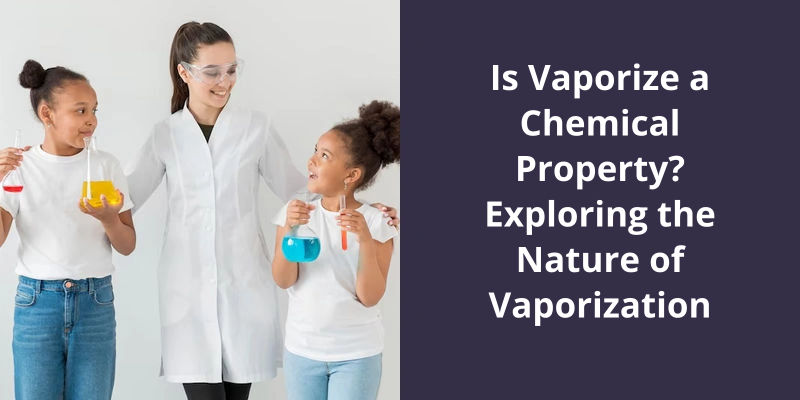Vaporization is not considered a chemical property. Rather, it is a physical property of a substance. A physical property is something we can measure or observe without changing the identity of the substance. In the case of vaporization, a substance changes from a liquid state to a gaseous state due to an increase in heat or pressure, but it remains the same substance. The molecules of the substance are simply moving faster and spread out more. Therefore, while vaporization involves a change of state, it does not involve a chemical reaction or any change in the substance’s chemical properties.

Is Heat of Vaporization a Physical or Chemical Property?
The heat of vaporization, also known as the enthalpy of vaporization, is a physical property that describes the amount of energy required to transform a liquid substance into it’s gaseous state at a constant temperature and pressure. It’s represented by the symbol ΔHvap, and it’s value is expressed in units of energy per mole or per gram of the substance.
Heat of vaporization is an important property for many industrial and research applications. For example, it’s used to determine the efficiency of distillation processes and to design heat exchangers for heat recovery. It also plays a crucial role in the production of steam, which is widely used in power generation and other industrial processes.
The values of heat of vaporization can vary greatly between different substances, depending on their molecular structure and intermolecular forces. For example, the heat of vaporization of water is much higher than that of ethanol, due to the stronger hydrogen bonding between water molecules.
One of the main factors that influence the heat of vaporization is the nature of the bonding between the atoms or molecules in the substance. In a covalent substance, such as water, the heat of vaporization is due to the energy required to break the hydrogen bonds between molecules. On the other hand, in ionic compounds, like sodium chloride, the heat of vaporization is determined by the energy required to overcome the strong electrostatic forces between the ions.
It’s determined by the molecular structure and intermolecular forces of the substance, and it’s important applications in many fields of science and industry. It’s a physical property because it doesn’t involve any chemical reaction or change in the chemical composition of the substance.
Now that we understand the basics of vaporization in physical science, it’s important to delve deeper into the specific applications and processes involved in this phenomenon. From industrial uses to scientific research, vaporization plays an integral role in various fields. Let’s explore some examples and insights into the world of vaporization.
What Is Vaporization in Physical Science?
In physical science, vaporization is a fundamental phenomenon that plays a critical role in various fields from chemistry to material science. This process refers to the transformation of a liquid state into a gaseous state by the addition of thermal energy. The boiling temperature of any liquid depends on the pressure it’s exposed to, and it’s the point at which vaporization begins. During vaporization, the kinetic energy of the molecules increases, and they break free from their bonds, becoming gaseous.
Vaporization is a critical process in the natural world. Water from lakes, oceans, and rivers evaporates under heat, turning into water vapor and entering the atmosphere. This vaporization is significant in the global weather patterns, the formation of clouds, and the global water cycle. When the water vapor reaches a high enough altitude, it condenses into tiny droplets and forms clouds. These clouds can release their moisture back to the earth as rain, snow, or hail, completing the cycle.
In the laboratory research, vaporization is crucial in analytical chemistry techniques. The most common technique involving vaporization is gas chromatography, where a sample is introduced into a vapor phase and separated into it’s various components. Another example involves the vaporization of a liquid sample to determine the amount of volatile material, which can be collected and weighed. Vaporization is also used in various industries, including the perfume, food, and chemical industries, where it’s used to remove solvents, for example, when extracting oils and flavors from plants.
There are several factors that determine the rate of vaporization. The surface area of the substance, the heat input, and the pressure all play vital roles. An open container of liquid left in a room will slowly vaporize because of the heat input from the environment, while covering the container will reduce the rate of vaporization.
From the natural world, where it’s necessary for weather patterns and the water cycle, to analytical chemistry techniques, where it’s crucial in separating compounds, vaporization is an essential process. Understanding the factors that control the rate and temperature of vaporization is essential in the industries that utilize the process.
Source: Vaporization
Now that we’ve established that the conversion of water into water vapours is a chemical change, it’s important to understand the implications of this process. Vapour has become an increasingly popular topic in recent years, with more and more people turning to vaping as a healthier alternative to smoking. However, there are still many misconceptions surrounding vapour and it’s effects on the body. In this article, we will explore the science behind vapour and dive deeper into the question of whether or not it’s a chemical change.
Is Vapour a Chemical Change?
When water is heated, it transforms into water vapour, but this process isnt a straightforward physical change. Rather, it’s a chemical change because the molecular composition of the substance has been altered. The conversion of water into vapour is known as evaporation, which occurs when heat energy is supplied to the liquid water to break the bonds holding it’s molecules together.
During this process, the water molecules gain enough kinetic energy to overcome the cohesive forces between them, which allows them to escape and move freely into the surrounding air. Water vapour molecules contain two hydrogen atoms and one oxygen atom, just like liquid water, but they exist in a different physical state and can exhibit distinct physical and chemical properties as a result.
Although it might seem like a simple physical transformation on the surface, it involves a complex series of chemical reactions that alter the molecular structure of the substance. These changes can have far-reaching effects on the substances properties and behaviour. With advances in scientific research and technology, scientists are beginning to gain a deeper understanding of the chemical dynamics underlying this transformation, which could have important implications for fields as diverse as atmospheric science and materials engineering.
Understanding the chemical properties of a substance is crucial in predicting it’s behavior in different environments. Chemical properties are inherent characteristics that describe how a substance interacts with other substances and undergoes chemical reactions. In this article, we will delve deeper into the four main chemical properties and explore some examples of each.
What Are the 4 Chemical Properties?
Chemical properties are the characteristics that describe the behavior of a substance when it interacts with other substances. These properties determine how a substance will react under various conditions, making them essential in fields like chemistry and chemical engineering. Understanding chemical properties is crucial for predicting the behavior of substances in various applications, such as in the production of medicines, fuels, and construction materials.
There are four primary chemical properties that scientists commonly observe. The first and perhaps the most well-known of these properties is flammability. This property determines how readily a substance will ignite or burn when exposed to an ignition source. The higher the flammability of a substance, the greater the risk of it catching fire, causing significant damage or harm to individuals and property.
Toxicity is another essential chemical property that scientists must consider. This property determines how harmful a substance is to humans, animals, and the environment. Substances with high levels of toxicity pose significant health risks and can cause long-term damage to biological systems when either ingested, inhaled, or absorbed through the skin. Therefore, scientists must carefully consider the toxicity of a substance before using it in manufacturing or other applications.
Chemical stability is a third crucial chemical property that describes how a substance reacts when exposed to various environmental conditions, such as heat, air, or light. Substances with high chemical stability don’t easily degrade and remain unchanged even under challenging environmental conditions. This property is particularly important in the production of medicines and other chemicals susceptible to degradation.
Lastly, the heat of combustion is another vital chemical property that determines how much heat energy is released when a substance undergoes combustion. Substances with higher heat of combustion release more energy when burned and can be more efficient fuels.
Conclusion
This chemical property is reversible, which means that the gas can return to it’s liquid form through a process called condensation. When changes of state occur, the molecules of a substance don’t undergo any chemical transformation or bonding. Instead, they rearrange themselves into new states of matter. These transformations are crucial in our daily lives as they’re responsible for various natural phenomena such as evaporation, precipitation, and cloud formation. Ultimately, understanding the properties of vaporization and other physical changes can help us comprehend the world around us better.





